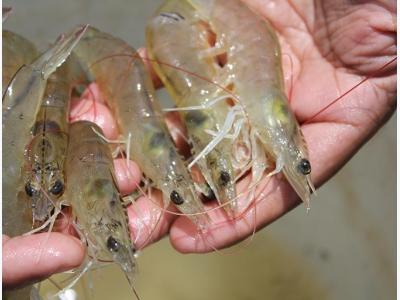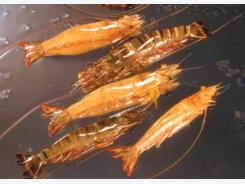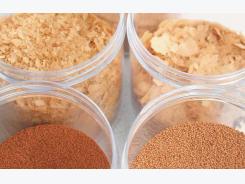Effects of Sterol supplements on Shrimp Growth, Survival

Summary:
Culture tanks used for sterol growth trial at TAES Shrimp Mariculture Research.
A study found the quality and levels of sterols in experimental feeds affected the growth performance of Pacific white shrimp. While shrimp grew best on a commercial control feed, they grew almost as well on semi-purified feeds supplemented with higher concentrations of purified and less-purified cholesterol. Other sterols partially satisfied their requirement for cholesterol.
Cholesterol is an essential dietary nutrient in shrimp. Like other crustaceans, shrimp cannot synthesize cholesterol, so dietary cholesterol is necessary for the animals’ growth and survival.
The optimum dietary level depends upon the shrimp species, feed and growth rates, and presence of other nutrients. Under a variety of conditions, the cholesterol requirements for Pacific white shrimp, Litopenaeus vannamei, have been reported as 0.05-0.5%.
Dietary phospholipids can facilitate the utilization of cholesterol by crustaceans and decrease their requirement for cholesterol. In L. vannamei fed to excess, cholesterol levels for optimum growth have been reported as 0.35, 0.14, 0.13, and 0.05% at phospholipid levels of 0, 1.5, 3.0, and 5.0%, respectively (Gong et al., 2000).
Supplementation
Required Although meals made from fish, shrimp, squid, crabs, and other animals containing cholesterol can provide a portion of the requirement for cholesterol in shrimp feeds, supplementation with purified cholesterol or other ingredients containing cholesterol is required to obtain optimum growth (Coutteau et al., 2002). However, cholesterol is a relatively expensive feed ingredient.
The apparent dietary requirement for cholesterol in crustaceans can potentially be satisfied by sterols other than cholesterol. The conversion of other sterols to cholesterol has been demonstrated in numerous crustaceans. However, the ability of other sterols to satisfy the cholesterol requirements for growth and survival is variable in crustaceans. Phytosterols, for example, are relatively ineffective as substitutes for cholesterol in shrimp (Teshima et al., 1989).
Cholesterol Supplements
To compare cholesterol supplements with different cholesterol and sterol compositions, the authors conducted a growth trial with L. vannamei using two cholesterol supplements. Cholesterol SF was a purified cholesterol product that contained 91% or more cholesterol and was 97% or more sterols. Cholesterol FG was a less purified product that contained 60% or more cholesterol and was 75% or more sterols. The FG product was about 10% less expensive than cholesterol SF.
To demonstrate the contribution of sterols other than cholesterol, a third sterol mixture, sterols M1M, was compared to cholesterols SF and FG. M1M contained 21% cholesterol and 63% total sterols. The composition of sterols other than cholesterol in M1M was similar to that in cholesterol FG.
Table 1. Cholesterol and total sterol levels in experimental diets.
Experimental Diets
Using purified and semipurified ingredients, experimental diets were formulated to contain five levels (0.00, 0.05, 0.10, 0.20, and 0.40%) of the supplements. In addition, a high-quality commercial feed was used as a control to compare the semipurified diets to a practical feed.
The diets formulations substituted the sterols for equal amounts of wheat starch. The primary protein sources were purified soy protein, casein, and wheat gluten. Krill meal was added at 2% as an attractant. To minimize the interaction between phospholipids and cholesterol, no supplemental phospholipid was added.
The diets were extruded at room temperature using carboxymethylcellulose as a binder. Proximate analysis of the experimental diets was 35.5% protein, 6.0% lipid, 8.2% ash, and 4% fiber.
Levels of cholesterol and total sterols in the feeds were calculated for each diet from the level of cholesterol in the base diet, the amount of sterol supplement in the diet, and the amounts of cholesterol and total sterols in the supplements (Table 1). Analyzed levels of cholesterol and proximate analysis constituents in the experimental feeds closely agreed with the calculated levels.
Growth Trial
In a 57-day growth trial, shrimp with an average weight of 0.21 g were stocked at a density of 4 shrimp/30-l tank. Heated, filtered sea water was recirculated through the tanks to remove uneaten feed and insure high water quality. Approximately 9-12% of the sea water was replaced daily. Salinity was maintained at 25-26 ppt, with temperature at 30-32° C.
Shrimp were fed 15 times daily with automatic feeders at a rate in excess of consumption. During the trial, temperature, dissolved oxygen, and salinity were measured daily. Ammonia, nitrite, nitrate, and pH were measured weekly. All water quality parameters were adequate for good growth and survival.
Survival
For the experimental diets, survival ranged from 64% for the diet without sterol supplementation to 91% for the diet with 0.4% cholesterol FG. Survival for shrimp on the control diet was 94%.
Growth
The effects of type and level of sterol supplement on growth are summarized in Figure 1. With the semipurified, experimental diets, weight gains ranged from 1.6 g for the diet without sterol supplements to 7.0 g for the diet with 0.4% cholesterol FG.Weight gain for the control was 9.7 g.
For the experimental diets, there was an interaction between type and level of sterol supplement. For the 0.05% level, growth on FG was greater than on M1M. For the 0.1- 0.4% levels, growth on both SF and FG was greater than on M1M, but the differences between SF and FG were small.
In general, growth increased with level of sterol. However, for SF, growth did not increase above 0.2%, and for FG and M1M, growth did not decrease below 0.1%. The results suggested that the requirement for cholesterol SF to give optimum growth was 0.16% and 0.25% for cholesterol FG.
The effects of cholesterol in the diets on growth are shown in Figure 2. The cholesterol SF data indicated that the requirement for cholesterol was 0.15% under the conditions of the trial. The growth values for cholesterol FG and sterols M1M were above that for cholesterol SF. This suggested that growth was greater than would have been expected on the basis of cholesterol alone, and that the sterols other than cholesterol in cholesterol FG and sterols M1M contributed to the increased growth.
The effects on growth of total sterols in the diets is shown in Figure 3. In contrast to the effects of cholesterol in the preceding figure, the growth response for sterols M1M was lower than the value generated for cholesterol SF, which suggested that the sterols in M1M were not as effective as the predominately cholesterol sterols in cholesterol SG.
Note: Cited references are available from the first author.
Related news
Tools

Phối trộn thức ăn chăn nuôi

Pha dung dịch thủy canh

Định mức cho tôm ăn

Phối trộn phân bón NPK

Xác định tỷ lệ tôm sống

Chuyển đổi đơn vị phân bón

Xác định công suất sục khí

Chuyển đổi đơn vị tôm

Tính diện tích nhà kính

Tính thể tích ao



 Challenges of RAS technology
Challenges of RAS technology  Intensive Farm In Bali, Indonesia, Produces Shrimp In…
Intensive Farm In Bali, Indonesia, Produces Shrimp In…